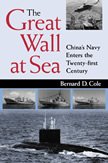HOME /
BOOKS / Book Review Great Wall At Sea/

The Great Wall at Sea:
China’s Navy Enters the Twenty-First Century
Book review by LtCol Jeff W. Bolander, USMC published in the July 2002 issue of The Marine Corps Gazette.
The Great Wall at Sea: China’s Navy Enters the Twenty-First Century.
By Bernard D. Cole.
Naval Institute Press, Annapolis, 2001, 288pp. $34.95.
ISBN: 1557502390
Despite serious concerns regarding the modernization of China’s Armed Forces, there are few good books available about the People’s Liberation Army (PLA). Of the few that have been published, most contain a strong political orientation and either assure us that the PLA is a century away from challenging America’s military, or alternatively, that we are on the verge of thermonuclear global war with the PRC. Fortunately, a recent release by the US Naval Institute, The Great Wall at Sea: China’s Navy Enters the Twenty-First Century, avoids the extremes of other books and provides a superior description and analysis of a branch of China’s military that has undergone significant change- the People’s Liberation Army Navy (PLAN).
In eight chapters, the author, retired US Navy Captain Bernard Cole, lays out the historical background to China’s Navy; describes its maritime interests; details the composition of the PLAN; and puts into perspective its current and projected capabilities. In addition to being exceptionally well laid out and written in an easily readable format, The Great Wall at Sea is notable for its extensive references. The footnotes and bibliography make up almost a third of the book and include excellent sources for further study of the PLA.
The principal theme of The Great Wall at Sea is that the PLAN has achieved significant progress in the past two decades by developing a Navy capable of coastal defense and executing "well defined campaigns to enforce sovereignty claims." The book convincingly makes the case that China’s Navy is ill prepared to directly confront the US, but that the PLAN should still be considered with caution because of its potential to achieve a coup de main in the South China Sea or against Taiwan.
The author’s background as a former Naval officer (which includes duty in Vietnam with Third Marine Division) and a faculty member of the National War College provides significant credibility to his analysis and descriptions of the PLAN. He often refers to his experiences as a surface warfare officer and to personal contacts he has made with Chinese military officers while visiting China. One of the key strengths of the book is the explanations of naval weapons systems and their relevance to the PRC’s overall plan to modernize their armed forces.
The book is much more than an Order of Battle handbook for the Chinese Navy. It is the best available resource for understanding the naval power of a country that has openly declared the United States to be its greatest threat. The concluding chapters covering China’s maritime strategy are noteworthy and make the book well worth the purchase price.
Gazette readers will find information on China’s two Marine Brigades of particular interest. The passages describing potential instances of US/PRC military conflict are relevant to Marines deployed to WESTPAC.
The author provides worst case-scenarios in which the PLAN could conduct military actions that would threaten US interests in the region. They include seizure of additional islands in the South China Sea, attacks against Taiwan, and disrupting commercial shipping in key SLOC’s.
Foremost of the potential conflicts that the PLAN is preparing for is their mission to prevent the
independence of Taiwan. The book describes this an "urgent scenario" facing PRC Naval planners and includes "Preparing for offensive operations against Taiwan" as first on a list of five specific missions facing the PLAN. Several warnings are included against providing an opportunity for China to exploit a decreased presence or level of preparedness of American forces in the Asia. A suggestion that in order to gain the initiative in a conflict involving the US, China might "...instigate a crisis on the Korean Peninsula to absorb Okinawa based Marines and the U.S. air forces in Japan and Korea" is especially insightful.
Dr. Cole has written a welcome alternative to other books on the Chinese military such as The China Threat , and The Great Wall and the Empty Fortress. Although they have shed important light on reasons to (or more often, to not) be concerned with the buildup of Chinese military power; their emphasis has been on the strategic level of war and their focus has been on attempting to address Chinese intentions rather than assess their military capabilities. The Great Wall at Sea differs by providing a detailed, balanced, and accurate description of a Navy that has a long way to go, but that has achieved remarkable progress in the past two decades.
LtCol Bolander is a PRC Foreign Area Officer currently assigned as the Commanding Officer of Company "D", MSG Battalion, 4th MEB (AT).
LtCol Bolander served as Deputy Naval Attache in Manila, Philippines From 1996-99. And was a close friend of the Philippine Marines.
Retail Price : $34.95
Item # 1557502390
Binding : HB
Era : Current
Number of Pages : 320
Number of Photos : 22
Number of Line Art Drawings: 0
Number of Color Photos: 0
Total Number of Illustrations: 28
Subject : Other Navies/Forces
http://www.usni.org/webstore/shopexd.asp?id=18922 US Naval Institute Link.